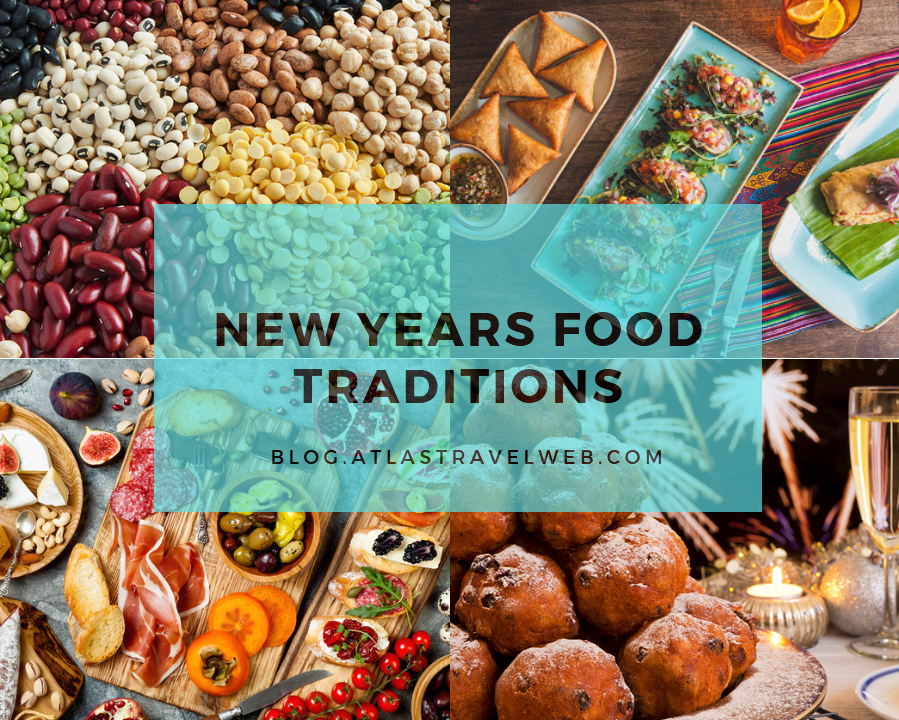Did you know that many cultures believe that way you eat on New Year Eve and New Year’s day will set the tone for the new year? As the new year arrives around the globe, special cakes and bread are a tradition, as well as noodles representing long life, field peas representing coins, herring representing abundance, and pigs representing good luck. The general theme is the same no matter what the traditions are: share food and drink with family and friends (virtually if need be,) to usher in a year of prosperity & good luck.
Here are some of the most New year’s food traditions:
- Hoppin’ John, U.S. – pork flavored field peas or black-eyed peas (symbolizing coins) and rice, served with collards or other cooked greens (the color of money) and cornbread (the color of gold) is said to bring good luck in the new year.
- Twelve grapes, Spain – eaten at midnight, one grape for every toll of the clock bell at the square in Puerta del Sol in Madrid. This tradition dates back to the 1800s. If you are going to attempt this, make sure and have seedless grapes. Make sure you start to eat the grapes when the official chimes start just after midnight. Pay attention to how the grapes taste. If your first grape happens to be sweet, welcome January with optimism because it’s supposed to guarantee good luck, while a sour one suggests bad vibes.
- Tamales, Mexico – corn dough stuffed with meat, cheese, and other additions and wrapped in a banana leaf or corn husk. Groups of women gather to make these little packets, with each person in charge of one aspect of the cooking process. Because of its golden color, it symbolizes wealth and property.
- Oliebollen, Netherlands – a doughnut-like dumpling of fried oil balls made by dropping a scoop of dough spiked with currants or raisins into a deep fryer and then dusted with powdered sugar. Eating oliebollen was considered a surefire way to ward off the whims of a cruel pagan goddess named Perchta. Tradition said that eating oliebollen protected you because the fat absorbed from the cooking oil made Perchta’s sword slide off of her victims.
- Marzipanschwein or Glucksschwein, Austria and Germany – they call New Year’s Eve Sylvesterabend, or the event of Saint Sylvester. In Austria revelers drink a red wine punch with cinnamon and spices, eat a suckling pig for dinner and decorate the table with little pigs made of marzipan. The marzipan pig is a traditional German and Scandinavian confectionery. In the German language, Schwein gehabt or “having a pig” means being lucky.
- Soba noodles, Japan – families eat buckwheat soba noodles or toshikoshi soba at midnight on New Year’s Eve to bid farewell to the year gone by and welcome the year to come. The long noodles symbolize longevity and prosperity. You should eat the noodle whole without biting into it. Another custom is called mochitsuki where friends and family spend the day before New Year’s pounding mocha rice cakes. The sweet rice is washed, soaked, steamed, and pounded into a smooth mass. The guests take turns pinching off pieces to make into small buns eaten for dessert.
- King cake – a New Year’s cake of many cultures. The Greeks have Vasilopita, the French gateau or galette des rois, the Mexicans Rosca de Reyes and Bulgarians banitsa. Most of the cakes are eaten at midnight on New Year’s Eve, though some cultures cut the cake on Christmas or the Epiphany, January 6. A gold coin or figure is hidden, which symbolizes a prosperous year for whomever finds it.
- Cotechino con lenticchie, Italy – a sausage and lentil stew said to bring good luck (the lentils represent money and good fortune). Italians celebrate La Festa di San Silvestro with a traditional cotechino con lenticchie and zampone, a stuffed pig’s trotter. The meal ends with chiacchiere, balls of fried dough rolled in honey and powdered sugar. Read more on New Years lucky soups.
- Pickled Herring, Poland and Scandinavia – eaten at the stroke of midnight to bring a year of prosperity and bounty do to the silver coloring. Some eat pickled herring in cream sauce while others eat it with onions. A special Polish preparation is called Sledzie Marynowane which is made by soaking whole salt herrings in water for 24 hours and then layering in a jar with onions, allspice, sugar and white vinegar. Scandinavians include herring in a large midnight smorgasbord with smoked pickled fish, pate, and meatballs. The silver coloring of the herring is said to bring a year of prosperity and bounty.
- Kransekage, Denmark and Norway – a wreath cake tower composed of many concentric rings of cake layered on top of one another using marzipan, with a bottle of wine or Aquavit in the center and decorated with ornaments, flags, and crackers. The cake’s turret-like shape is reminiscent of a cornucopia, the horn of plenty, which promises wealth and happiness in the New Year.
We invite you to read more about New Years Traditions & New Years Superstitions from around the world.








